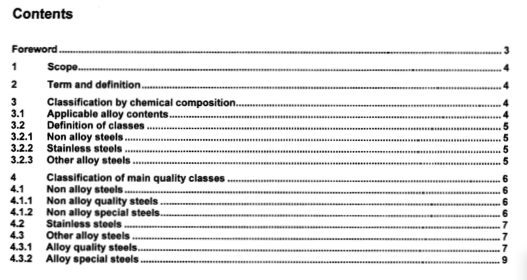BS EN 10020:2000 – efinition and classification of rades of steel

1 Scope
This European Standard defines the term “steel” (see clause 2) and classifies steel grades into:
– non alloy, stainless steel and other alloy steels by chemical composition (see clause 3);
– main quality classes (see clause 4) defined by main property or application characteristics for non alloy,
stainless and other alloy steels.
2 Term and definition
For the purposes of this standard, the following term and definition apply:
2.1
steel
material which contains by mass more iron than any other single element, having a carbon content generally less than 2 % and containing other elements. A limited number of chromium steels may contain more than 2 % of carbon, but 2 % is the usual dividing line between steel and cast iron
3 Classification by chemical composition
3.1 Applicable alloy contents For European Standards the classification given in the product standard or specification applies regardless of the steel which is actually produced, provided that the chemical composition complies with the requirements of the standard concerned.
3.1.1 determined by the minimum value specified for each element. Classification is based on the ladle analysis specified in the product standard or specification and is
3.1.2 Where for elements other than manganese a maximum value only is specified in the product standard or specification for the ladle analysis, a value of 70 % of this maximum value shall be taken for classification as set out in Tables 1 and 2. For manganese see note a) of Table 1.
3.1.3 Where a product standard or specification is based on product analysis an equivalent ladle analysis is calculated using the permitted deviations from ladle analysis specified in the product standard or specification or corresponding European Standard or EURONORM.
3.1.4 classification is based on the actual ladle analysis reported by the manufacturer. In the absence of a product standard or specification or a precisely specified chemical composition,
3.1.5 The results of product analysis may deviate from those of the ladle analysis to an extent permitted by the appropriate product standard or specification (such deviations do not affect the classification of the steel as non alloy or alloy). If the product analysis indicates a value, which would place the steel in a class other than intended, then its inclusion in the clas i originally intended shall be separately and reliably substantiated.
3.1.6 product, which has been coated or clad. Composite or coated products are classified according to the specified chemical composition of the
3.1.7 For each alloy element, the specified, calculated or actual ladle analysis value is expressed to the same number of decimal places as the corresponding limit value shown in Table 1. For example in this European Standard a specified range of 0,3 % to 0,5 % corresponds to a range of 0,30 % to 0,50 %. Similarly a specified content of 2 % is taken to mean a content of 2,OO %.
BS EN 10020:2000 – efinition and classification of rades of steel